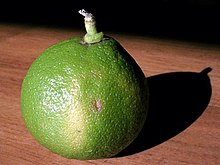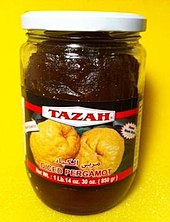Bergamot orange
| Bergamot orange Citrus bergamia | |
|---|---|

| |
| Scientific classification | |
| Kingdom: | Plantae |
| Clade: | Tracheophytes |
| Clade: | Angiosperms |
| Clade: | Eudicots |
| Clade: | Rosids |
| Order: | Sapindales |
| Family: | Rutaceae |
| Genus: | Citrus |
| Species: | C. bergamia
|
| Binomial name | |
| Citrus bergamia Risso[1]
| |
| Synonyms[2] | |
| |
Citrus bergamia, the bergamot orange (pronounced /ˈbɜːrɡəmɒt/), is a fragrant citrus fruit the size of an orange, with a yellow or green color similar to a lime, depending on ripeness.
Genetic research into the ancestral origins of extant citrus cultivars found bergamot orange to be a probable hybrid of lemon and bitter orange.[3] Extracts have been used as an aromatic ingredient[4] in food, tea, snus, perfumes, and cosmetics. Use on the skin can increase photosensitivity, resulting in greater damage from sun exposure.[5]
Citrus bergamia is commonly confused with Citrus hystrix, which is often called the Thai Bergamot. The citrux hystrix looks distinctively different and is used to advertise products based on citrus bergamia.[6]
Etymology[]
The word bergamot is etymologically derived from the Italian word bergamotto,[7] ultimately of Turkish origin: bey armudu or bey armut ("lord's pear" or "lord pear").[8]
Description[]
Citrus bergamia is a small tree that blossoms during the winter. The juice tastes less sour than lemon, but more bitter than grapefruit.[citation needed]
Phytochemicals[]
Bergamot fruit contains flavonoid phytochemicals, such as neoeriocitrin, naringin, neohesperidin, ponceritin, melitidin, mitrocin, miriflin, and brutieridin.[9] Bergamot leaves contain different indole alkaloids, such as N,N,N-trimethyltryptamine.[10]
Taxonomy[]
The bergamot orange is unrelated to the herbs known as bergamot, wild bergamot, bergamot mint, or bergamint – Monarda didyma, Monarda fistulosa, and Eau de Cologne mint (the taxonomy of which is disputed). Those are all in the mint family, and are named for their similar aroma.
Citrus bergamia has also been classified as Citrus aurantium subsp. bergamia (i.e. a subspecies of bitter orange).[11]
Citrus bergamia is sometimes confused with (but is not the same as):
- Citrus medica – citron, the yellow fruit of which is also known as etrog; or
- Citrus limetta, the "sweet lemon" or "sweet lime".
Citrus bergamia is often confused with Citrus hystrix or the makrut lime. This is due to the makrut lime also being called a Thai bergamot. Though the two fruits look quite different, there is still widespread misinformation on what Citrus bergamia looks like.[citation needed]
Production[]

The bergamot is a citrus fruit native to southern Italy. Production is mostly limited to the Ionian Sea coastal areas of the province of Reggio di Calabria in Italy, to such an extent that it is a symbol of the entire city. Most of the bergamot comes from a short stretch of land there, where the temperature is favourable. The fruit is also produced in Argentina, Brazil, Algeria, the Ivory Coast, Morocco, Tunisia, Turkey, and South-East Asia.
Citrus bergamot is commercially grown in southern Calabria (province of Reggio), southern Italy. It is also grown in southern France[12] and the Ivory Coast for the essential oil and in Antalya in southern Turkey for its marmalade.[13] The fruit is not generally grown for juice consumption.[4] However, in Mauritius where it is grown on a small-scale basis, it is largely consumed as juice by the locals.
One hundred bergamot oranges yield about three ounces (85g) of bergamot oil.[14]

Adulteration with cheaper products such as oil of rosewood and bergamot mint has been a problem for consumers. To protect the reputation of their produce, the Italian government introduced tight controls, including testing and certificates of purity. The Stazione Sperimentale per le Industrie delle Essenze e dei Derivati dagli Agrumi (Experimental Station for Essential Oil and Citrus By-Products) located in Reggio di Calabria, was the quality control body for the essential oil Bergamotto di Reggio Calabria DOP.[15] During World War II, Italy was unable to export to countries such as the Allied powers. Rival products from Brazil and Mexico came on to the market as a substitute, but these were produced from other citrus fruits such as sweet lime.[16]
Uses[]
Tea and other uses[]

An essence extracted from the aromatic skin of this sour fruit is used to flavour Earl Grey and Lady Grey teas,[11] as well as confectionery (including Turkish delight).[17] Bergamot is one of the most common "casings" (flavorings) added to Swedish snus, a form of smokeless tobacco product.
Fragrance[]
Bergamot oil is one of the most commonly used ingredients in perfumery.[18] It is prized for its ability to combine with an array of scents to form a bouquet of aromas that complement each other.[19] Bergamot is a major component of the original Eau de Cologne composed by Jean-Marie Farina at the beginning of the 18th century in Germany. The first use of bergamot oil as a fragrance ingredient was recorded in 1714, and can be found in the Farina Archive in Cologne. However, much "Bergamot oil" is today derived instead from eau de Cologne mint, also known as bergamot mint, which is a variety of water mint and is unrelated to citrus.[citation needed]
Toxicology[]
In several patch test studies, application of some sources of bergamot oil directly to the skin of guinea pigs was shown to have a concentration-dependent phototoxic effect of increasing redness after exposure to ultraviolet light (due to the chemical bergapten, and possibly also citropten, bergamottin, geranial, and neral).[20][21] This is a property shared by many other citrus fruits and other members of Rutaceae including Rue. Bergapten has also been implicated as a potassium channel blocker; in one case study, a patient who consumed four litres of Earl Grey tea per day (which contains bergamot essential oil as a flavouring) suffered muscle cramps.[22]
Bergamot is also a source of bergamottin.[citation needed]
Skin effects[]

Used in cosmetics and perfume products, bergamot may cause skin irritation.[5] In the past, psoralen extracted from bergamot oil was used in tanning accelerators and sunscreens. Known to be photocarcinogenic since 1959,[23] the substances nonetheless were used in tanning activators until 1995,[24] contributing to many cases of melanoma and death.[25]
Research[]
As of 2017, clinical research conducted on bergamot oil has been of poor quality, with no conclusions about its possible biological effects.[26][27] Consuming bergamot oil as a component of tea may cause muscle cramps.[5] Use on the skin may be unsafe, particularly for children and pregnant women, and may cause rashes resulting from photodermatotoxicity.[5]
References[]
- ^ The International Plant Names Index, retrieved 2 June 2015
- ^ Porcher, Michel H.; et al. (1995), Multilingual Multiscript Plant Name Database (M.M.P.N.D): Sorting Citrus Names, The University of Melbourne
- ^ Curk, Franck; Ollitrault, Frédérique; Garcia-Lor, Andres; Luro, François; Navarro, Luis; Ollitrault, Patrick (2016). "Phylogenetic origin of limes and lemons revealed by cytoplasmic and nuclear markers". Annals of Botany. 117 (4): 565–583. doi:10.1093/aob/mcw005. PMC 4817432. PMID 26944784.
- ^ Jump up to: a b Davidson, Alan (2006). Jaine, Tom (ed.). The Oxford Companion to Food (Second ed.). p. 75. ISBN 0-19-280681-5.
The bergamot orange is not edible and is grown only for its fragrant oil, although its peel is sometimes candied.
- ^ Jump up to: a b c d "Bergamot oil". Drugs.com. 2018. Retrieved 30 November 2018.
- ^ The Internet Does NOT Know What BERGAMOT Is (The Fascinating Reason Why) - Weird Fruit Explorer, retrieved 2021-06-09
- ^ "Online Etymology Dictionary". etymonline.com.
- ^ "Collins Dictionaries - Free Online". collinsdictionary.com.
- ^ Cappello, AR, Dolce V, Iacopetta D, Martello M, Fiorillo M, Curcio R, Muto L, Dhanyalayam D. (2015). "Bergamot (Citrus bergamia Risso) Flavonoids and Their Potential Benefits in Human Hyperlipidemia and Atherosclerosis: an Overview". Mini-Reviews in Medicinal Chemistry. 16 (8): 1–11. doi:10.2174/1389557515666150709110222. PMID 26156545.
- ^ Servillo, Luigi; Giovane, Alfonso; Balestrieri, Maria Luisa; Casale, Rosario; Castaldo, Domenico (2013-05-17). "Citrus genus plants contain N-methylated tryptamine derivatives and their 5-hydroxylated forms". Journal of Agricultural and Food Chemistry. 61 (21): 5156–5162. doi:10.1021/jf401448q. ISSN 1520-5118. PMID 23682903.
- ^ Jump up to: a b "Citrus bergamia". Germplasm Resources Information Network (GRIN). Agricultural Research Service (ARS), United States Department of Agriculture (USDA). Retrieved 2011-09-07.
- ^ "Bergamot Orange - Citrus aurantium ssp bergamia". tradewindsfruit.com.
- ^ Aktas, Ali (26 October 2004). "Reçellerin gözdesi, Bergamut(The most prominent marmalade: Bergamot)". ZAMAN. Archived from the original on 18 April 2013. Retrieved 26 April 2012. Cite journal requires
|journal=(help) - ^ Brannt, William Theodore; Schaedler, Karl. A Practical Treatise on Animal and Vegetable Fats and Oils
- ^ "Decreto 15 novembre 2005 – Designazione della Stazione sperimentale per le industrie delle essenze e dei derivati degli agrumi quale autorità pubblica, incaricata di effettuare i controlli sulla denominazione di origine protetta "Bergamotto di Reggio Calabria", registrata in ambito Unione europea, ai sensi del regolamento (CEE) n. 2081/92" (PDF). ISMEA. Archived from the original (PDF) on 2012-04-25.
- ^ Board, Niir (2011). "Oil of Bergamot." The Complete Technology Book of Essential Oils (Aromatic Chemicals). p. 75. ISBN 978-81-7833-066-2.
- ^ Garbee, Jenn (2011, January 06). Three generations of Turkish delight in Southern California. Los Angeles Times.
- ^ Zoe Diana Draelos (14 October 2015). Cosmetic Dermatology: Products and Procedures. Wiley. pp. 57–. ISBN 978-1-118-65546-7.
- ^ Giovanni Dugo; Ivana Bonaccorsi (23 August 2013). Citrus bergamia: Bergamot and its Derivatives. CRC Press. pp. 467–. ISBN 978-1-4398-6229-2.
- ^ Girard J, Unkovic J, Delahayes J, Lafille C (1979). "Phototoxicity of Bergamot oil. Comparison between humans and guinea pigs". Dermatologica (in French). 158 (4): 229–43. doi:10.1159/000250763. PMID 428611.
- ^ Kejlova K, Jirova D, Bendova H, Kandarova H, Weidenhoffer Z, Kolarova H, Liebsch M (2007). "Phototoxicity of bergamot oil assessed by in vitro techniques in combination with human patch tests". Toxicology in Vitro. 21 (7): 1298–1303. doi:10.1016/j.tiv.2007.05.016. PMID 17669618.
- ^ Finsterer, J (2002). "Earl Grey tea intoxication". Lancet. 359 (9316): 1484. doi:10.1016/S0140-6736(02)08436-2. PMID 11988248. S2CID 26873836.
- ^ Urbach, F (1959). "Modification of ultraviolet carcinogenesis by photoactive agents". J Invest Dermatol. 32 (2, Part 2): 373–378. doi:10.1038/jid.1959.63. PMID 13641813.
- ^ Autier P, Dore JF, Schifflers E, et al. (1995). "Melanoma and use of sunscreens: An EORTC case control study in Germany, Belgium and France". Int. J. Cancer. 61 (6): 749–755. doi:10.1002/ijc.2910610602. PMID 7790106. S2CID 34941555.
- ^ Autier, P.; Dore, J.-F.; Cesarini, J.-P.; Boyle, P. (1997). "Should subjects who used psoralen suntan activators be screened for melanoma?". Annals of Oncology. 8 (5): 435–437. doi:10.1023/A:1008205513771. ISSN 0923-7534. PMID 9233521.
- ^ Mannucci, C.; Navarra, M.; Calapai, F.; Squeri, R.; Gangemi, S.; Calapai, G. (2017). "Clinical pharmacology of Citrus bergamia: A systematic review". Phytotherapy Research. 31 (1): 27–39. doi:10.1002/ptr.5734. PMID 27747942. S2CID 12136775.
Bibliography[]
- Dugo, Giovanni; Bonaccorsi, Ivana (2013). Citrus bergamia: Bergamot and its Derivatives. Medicinal and Aromatic Plants – Industrial Profiles (Book 51). CRC Press. ISBN 978-1439862278.
External links[]
| Wikimedia Commons has media related to Citrus Bergamia group. |
- Calabria
- Citrus hybrids
- Flora of Greece
- Flora of Iran
- Flora of Italy
- Oranges (fruit)
- Ark of Taste foods
